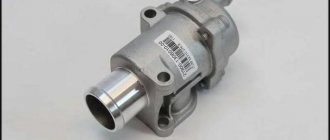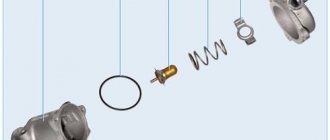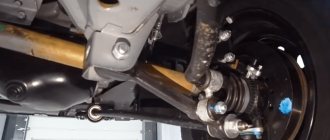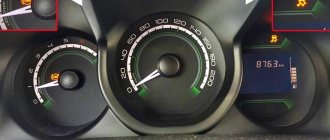VAZ cars of different models differ in the operating principles of many systems. There is a difference in the engine cooling and interior heating systems.
The article describes how to install a Granta thermostat on a VAZ-2110.
The main differences between the engine heating systems of the two models will be described, as well as the best thermostats that can be used for replacement.
Cooling System Differences
Before replacing the thermostat, you need to know the difference between the Granta and VAZ-2110 cooling systems. It is precisely because of the big difference that owners experience difficulties when operating the standard VAZ-2110 thermostat.
VAZ-2110
On the 2110, a common problem is leakage of coolant through the pipe connections. The reason is excess antifreeze pressure when the engine operates in various modes.
Manufacturers designed the small-circle heating system without taking into account the heater radiator. It was connected to the system in parallel, through the water pump pipe. To ensure the required pressure, a narrowing of the part of the bypass channel in front of the bypass valve was used.
While the power unit is warming up, antifreeze moves through the engine cooling lines through the pump, and only then into the interior heating radiator. The thermostat, using a bypass valve, regulates the flow of liquid into the “stove”. This valve opens as the temperature increases and the engine speed increases as the pressure in the system begins to rise.
Thus, a system with parallel connection of the VAZ-2110 thermostat interior heating is not effective. Its disadvantages are as follows:
- Long process of warming up the interior.
- Dependence of warming up on engine speed.
- Vulnerability of joints to high antifreeze pressure.
- Antifreeze boiling in the expansion tank or radiator. Boiling does not occur from overheating, but from a pressure difference after opening the circulation to a large circle.
Even replacing thermostats with five and six taps to separate the circulation does not help eliminate the main problem - poor heating. The narrowing of the bypass channel, which was made to increase the circulation rate in the heating radiator, affected the change in pressure at various speeds.
VAZ-2110 cars with a 16-valve power unit were equipped with a heating radiator with a larger internal volume than, for example, models 2109. This is also a good reason, since unstable pressure and parallel connection did not help level the temperature of the interior and engine.
Lada Granta
Here the whole system is much more efficient. During warming up, antifreeze fills the power unit and the heating radiator evenly. This occurs due to the serial connection of the heating radiator to the primary heating system. Now there is no pressure difference, the water pump does not affect the amount of antifreeze in the “stove” radiator. Driving and the interior warm up equally evenly. The design of the radiator was not a problem either. Antifreeze completely fills the entire volume, without creating air pockets or boiling.
Advantages of serial connection:
- The car interior begins to receive warm air after reaching a temperature threshold of 55–60 degrees.
- There are no problems with depressurization of connections.
- There is no overheating at idle (an additional fan helps with this).
- The power unit warms up much faster.
- Depending on the thermostat used, the operating temperature is always maintained at 80–90 degrees.
The cooling system based on the Lada Granta principle has more advantages. Replacement will help warm up the interior and power unit faster and more efficiently in areas with very low temperatures in winter. Next, we will describe the installation of a thermostat from Granta on a VAZ-2110.
general information
There are single-valve, two-stage and two-valve thermostats, as well as electronically controlled devices. Grants are equipped with thermostats Luzar LT0191 and Luzar LT0190 (costing from 450 rubles for the first, and from 800 rubles for the second), FENOX TS034E7 (costing from 800 rubles), VAZ-2123 (article 2123-1306010, cost from 650 rub.). It is worth mentioning such devices as VAZ-2101 GATES (article TH14580, cost - from 350 rubles), VAZ-2121 GATES (article TH15380, approximate cost - from 500 rubles), VAZ-2110 (article 21082-1306010, cost - from 600 rub.) and other devices. They are located between the engine and the radiator, but it should be noted that there are differences in the location of the thermostats on Grants with eight-valve and sixteen-valve engines.
Their main task is to prevent the movement of antifreeze through the radiator until the car engine warms up to the required temperatures. Accordingly, if the car engine does not warm up, then the coolant does not move in a large circle. Usually the thermostat is activated when the engine reaches a temperature of 80-95C. Among other things, the thermostat helps reduce the amount of harmful emissions released into the atmosphere and minimize engine wear.
The thermoelement located inside the device is made of brass, has a cylindrical shape and is filled with artificial wax. When the engine reaches a temperature of approximately 82C, this substance begins to melt, which causes it to expand. This sets the valve in motion, it opens, after which the antifreeze begins to circulate through the car’s radiator. Turning off the motor causes the wax to solidify inside the thermostat and close the damper.
Below we will talk in more detail about possible malfunctions of thermostats, provide instructions for replacing and checking them, and also share a technique for reworking and upgrading this part, allowing you to increase its response threshold to 92C.
Replacement
Before you begin replacing the thermostat, you must purchase the necessary consumables. To work you will need:
- Thermostat from Lada Granta. The kit should include a gasket. Models with a plastic body are not suitable for replacement.
- A pipe for connecting to the lower “bathtub” of the radiator, also from Granta.
- Steel studs “M8”, at least 9 cm long. If possible, it is better to purchase stainless steel fasteners.
- Steel washer. Required for installation under a temperature sensor.
- Connecting clamps.
- Metal tee.
- Silicone-based sealant with a temperature threshold of at least 300 degrees.
Below is a step-by-step process for replacing a thermostat from Granta.
- Allow the power unit to cool.
- Drain some of the antifreeze into a container.
- Remove all drain pipes from the standard thermostat. The connections between the pipes should be checked for cracks. The inside of the pipes must be cleaned of dirt and oxidation.
- Unscrew the fastening studs. Before dismantling, it is necessary to clean the area where the pin enters the block. Aluminum often oxidizes the metal. The pin may break when unscrewed.
- Clean the seat from old gasket and sealant. It is better to clean it with a wooden strip so as not to deform the joint.
- Screw in the prepared studs. It is very important to lubricate the threads with grease. This way the fasteners will not oxidize in contact with aluminum. Reinstall the gasket. The factory gasket does not need to be lubricated with a sealant.
- Install the new circulation regulator in place.
- Install a pipe from the lower “bath” of the radiator to the engine drain.
- Plug the pipe from the throttle valve. For this, two steel clamps and an M10 bolt are used.
- Install all pipes. When installing, shorten the heating pipe by 5 centimeters and secure it. An uncut hose will stick out and will be difficult to install and then secure.
- Connect the drains from the heating system and expansion tank through a tee.
- Reinstall the temperature sensor.
- Pour the missing amount of antifreeze into the system.
- Start the power unit.
It is very important to coat all connections with sealant. This will prevent depressurization and protect the inner surface of the thermostat pipes and outlets.
For the VAZ-2110, the best choice would be a thermostat with a temperature threshold of 92 degrees. Such a regulator will more effectively warm up the car interior. When installing, you should carefully select antifreeze for such a thermocouple.
Thermostat VAZ 2112 16 valves from grants
Added after 18 minutes 6 seconds:
Write detailed names of stove radiator manufacturers.
I changed it 2 years ago, and I don’t remember exactly what manufacturer it was. I remember exactly that after the replacement there was no difference in the heating of the interior, i.e. everything was blowing hot perfectly.
If I hadn’t walked in a big circle, the engine would have started boiling even at -10 on the street.
Nothing flows in a large circle, I checked the pipes more than once at about 80 degrees, they were icy once and were barely warm, but the pipe to the stove was hot
There you also need to install the heater radiator so that air does not flow into the cracks around it, there they seem to seal the rubber around it.
That is, the radiator was replaced and the disappearance of the coolant did not stop?
Siphoned, replaced, and the leak stopped
This indicates that the engine is faulty. Check the compression first.
It can burn with slight etching.
What about the candles? Should be black at high flow rates.
I haven’t added a single gram of antifreeze since the coolant circulation system was redone.
I bought a car 2.5 years ago, initially everything was fine with the heater, but the coolant was leaking somewhere (in the end the heater radiator siphoned off and was replaced), if you constantly top it up, it was very comfortable in the car. But last winter I was noticeably freaked out by the weather in the cabin, nothing helped, not even topping up,
then I turned it up to 92 and fire
You can burn valves and gaskets
At 10, I also suffered with the stove and changed thermoses and installed an additional pump, immediately threw it away, disassembled the body and put it back together - rubbish, the DaAZ heater helped. One question, did you mix up the pipes when you redid them? The fact that it doesn’t heat up on low speed is a mystery, you’ll be clutching at a straw, try unscrewing the lid halfway, it will warm up, I drive like that in 10 and on Kalina - it’s hot in the cabin.
The pump is still a collective farm. Today I noticed an interesting feature, I turned the air flow from the stove towards myself and snow flew into my face) At the same time, the flow was not completely cold, warm, so to speak. A car without a cabin filter, because there is nowhere to put it, a car with an air conditioner and the AvtoVAZ engineers decided why the hell this filter is needed at all, let's shove an evaporator in there. BUT, there shouldn’t be any snow there, because judging by the pipe that goes to the heater radiator - the latter is very hot, the snow should have melted long ago on the way to such a radiator. It turns out that not all of the air flow passes through the radiator? And what could be the reason for such an anomaly? Regarding the pipes, I definitely didn’t mix up anything, I checked it 20 times when I installed it, because I was afraid of it myself) Regarding the cap of the expansion tank, I also noticed an interesting feature, earlier on the old tank, when unscrewing it when it was hot, it “puffed”, now it doesn’t puff at all , I’ve already replaced 3 pieces, not a single one is leaking. Is this abnormal? And regarding the underheating of the engine, for a couple of days the weather became a little warmer, at -5 it heats up to 85, at -10-15 it heats up to a maximum of 70, and then after half an hour of driving.
Source
Best models
The following will be a list of the most suitable thermostats for the Lada Granta in terms of price and quality.
HQ-mech
The company specializes in the production and resale of spare parts, including for VAZ cars. HQ-mech thermostats for Lada Granta are marked with article number HQ-2190-1306010. The device valve is made of stainless steel and has an additional anti-corrosion coating. Thermostats under the article number HQ-2190-1306010 have an opening threshold of 85 degrees. Suitable for car operation at temperatures down to −20 degrees.
Advantages:
- Low price;
- High build quality;
- Use of anti-corrosion coatings and materials.
Thermostats of this brand have proven themselves to be excellent among domestic car enthusiasts.
LUZAR
Thermostats of this brand are available with an opening threshold of 85 degrees. Some LUZAR models are labeled “winter”, their response threshold is up to 92 degrees. This model is perfect for operation at −20 and below. The brand has long established itself as a manufacturer of high-quality automobile spare parts.
Advantages:
- Average price;
- Build quality;
- Low operating error.
- Long service life.
When purchasing, you should pay close attention to the opening temperature markings.
PEKAR
PEKAR are excellent for use on Lada Granta.
They have an opening temperature threshold of 87 degrees, with a very low operating error. The valve bowl is made of stainless steel, the thermoelement tube is made of purified copper. The company has been on the Russian and CIS markets for quite some time.
Among the advantages:
- Average price.
- Great build.
- Long service life.
- Low error.
The thermostat of this brand is perfect for use at low temperatures.
The advantages of this development
- The main and significant advantage of replacing the thermostat with a Grant thermostat is the warmth in the car interior. Warm air begins to blow from the nozzles already at a temperature of 50 degrees, and at 70 degrees it is hot.
- Quickly warms up the engine even in the most severe frosts, which will allow you to quickly warm up the interior and drive in comfort.
- The coolant temperature when driving will not drop below 85 degrees
- In summer, the engine will not overheat. The temperature will not exceed 100 degrees
2112 is heating up with SOD from grants
Welcome to ChipTuner Forum.
Theme Options
VAZ 2112 2002 Guards 16k There is a Grant thermostat. The only difference is that the supply hose and drain hose on the salt heater have been swapped (small circle). It turns out that the steam pipe (which is on the interior heater) should be on the inlet, but in my diagram it is on the drain (since I swapped the inlet and outlet of the stove). The problem is the following - after replacing the inlet and outlet through the steam exhaust pipe of the stove, much less antifreeze leaks into the reservoir (you have to rev it hard to get the antifreeze out). In the city (at 20 degrees of heat) the car holds 93 degrees, if in the neighborhoods it reaches 100 degrees and Carlson is on. This has never happened before. Previously, Carlson only turned on in the heat when standing in a traffic jam. (On the highway the car keeps 88-90 degrees, the thermostat opens at 88 degrees) Could this be due to the reversal of inlet and outlet on the heater? Perhaps this is why the air lock cannot come out? Or is air being sucked in through the heater steam pipe?
Just please don’t raise the topic “why did I swap them?” I thought that with the exchange the heater would work more efficiently, because... The steam outlet tube, with this scheme, will not take antifreeze from the supply.
Here's a stove, pay attention to where the steam outlet is.
Source
Removal
Before replacing a broken thermostat, you need to remove it:
- Unscrew the cap from the expansion tank; this is necessary so that antifreeze flows normally out of the system;
- Remove the plug from the drain hole at the bottom of the radiator tank, first replace it with a clean container and drain the antifreeze;
- Remove the entire thermostat assembly. Or, if you prefer, just its thermocouple.
In the latter case:
Technical points
Regardless of the vehicle brand, the ODS consists of the following elements:
- Water pump.
- Electric fan.
- Radiator.
- Expansion tank with plug.
- Thermostat.
On a cold engine, the valve of the latter device closes the pipe going to the radiator. In this case, coolant circulation is observed in a small circle (without a radiator). On the “ten”, the radiator, intake manifold, BDK, and liquid chamber are involved in a small circle. At a temperature of 87°C, movement of the thermostat is observed. This opens the main pipe. The liquid begins to circulate in a large circle. If the temperature reaches 102°C, then the pipe opens completely. The valve stroke is allowed within 8 mm.










